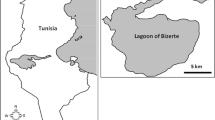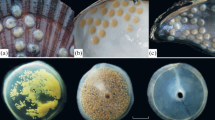Abstract
The relationships between the linear dimensions and body weight and the ratio between the masses, growth, and production were studied for the bivalve Astarte borealis inhabiting the southeastern Baltic Sea. The maximal shell length was 21.09 mm, while the maximum age was 8+. The linear growth was described by the Bertalanffy equation L τ = (1 - e -0.0894(τ-(-0.7354))). The annual production was 7.60 kJ/m2 at a P s/B coefficient of 0.41. It was found that the A. borealis inhabiting the southeastern Baltic Sea was characterized by a lower linear growth rate compared to the mollusks of other parts of the geographical range due to the low salinity of the Baltic Sea.
Similar content being viewed by others
References
A. F. Alimov, A. A. L’vova, G. E. Makarova, et al., “Growth and age,” in Study Methods of Bivalves (Akad. Nauk SSSR, Leningrad, 1990a), pp. 121–140.
A. F. Alimov, G. E. Makarova, and N. V. Maksimovich, “Calculation of production output,” in Study Methods of Bivalves (Akad. Nauk SSSR, Leningrad, 1990b), pp. 179–195.
T. V. Antipova, “Production of some populations of Bivalves in southeastern part of the Barents Sea and Southern Kara Sea,” Okeanologiya (Moscow) 18(4), 737–741 (1978).
S. Yu. Gagaev, “Growth and production of mass species of bivalves in Chaunskaya Bay, East-Siberian Sea,” Okeanologiya (Moscow) 29(4), 658–662 (1989).
A. A. Gusev and E. M. Jurgens-Markina, “Growth and production of the bivalve Macoma balthica (Linnaeus, 1758) (Cardiida: Tellinidae) in the southeastern part of the Baltic Sea,” Russ. J. Mar. Biol. 38(1), 56–63 (2012).
L. A. Zenkevich, Biology of the USSR Seas (Akad. Nauk SSSR, Moscow, 1963) [in Russian].
V. V. Kozlovskiy, M. V. Chikina, N. V. Kucheruk, et al., “Structure of the macrozoobenthic communities in the southwestern Kara Sea,” Oceanology (Engl. Transl.) 51(6), 1012–1020 (2011).
E. B. Lebedev, “Composition of sublittoral bivalves in the Far East Marine Nature Reserve (Peter the Great Gulf, Sea of Japan),” Byull. Dal’nevost. Malakol. O-va, No. 14, 67–97 (2010).
N. V. Maksimovich and V. V. Pogrebov, Quantitative Analysis of Hydrobiological Material (Leningr. Gos. Univ., Leningrad, 1986) [in Russian].
N. V. Maksimovich, A. V. Gerasimova, and T. A. Kunina, “Production capacity of the settlements of Macoma balthica L. in Chupa Bay (the White Sea). II. Production,” Vestn. St.-Peterb. Gos. Univ., Ser. 3 1(3), 3–11 (1993).
A. S. Plotkin, A. I. Railkin, E. I. Gerasimova, et al., “Subtidal underwater rock communities of the white sea: Structure and interaction with bottom flow,” Russ. J. Mar. Biol. 31(6), 335–343 (2005).
N. I. Selin, “Shell form, growth and life span of Astarte arctica and A. borealis (Mollusca: Bivalvia) from the subtidal zone of northeastern Sakhalin,” Russ. J. Mar. Biol. 33(4), 278–283 (2007).
V. I. Filatova, “Class Bivalvia (Lamellibranchiata),” in Key to Identification of Fauna and Flora of Northern Seas of USSR (Sov. Nauka, Moscow, 1948), pp. 405–446.
A. A. Jarvekulg, “Characteristics of zoobenthos in eastern part of the Central Baltic in summer 1965,” in Fishery Studies in the Baltic Sea Basin (Avost, Riga, 1970), No. 5, pp. 16–42.
A. A. Jarvekulg, Bottom Fauna of Eastern Part of the Baltic Sea (Valgus, Tallinn, 1979) [in Russian].
A.-B. Andersin, J. Lassing, and H. Sandler, “Community structure of soft-bottom macrofauna in different parts of the Baltic,” in 11th European Symposium on Marine Biology, Biology of benthic organisms: Galway, October 1976, Ed. by B. F. Keegan, et al. (Pergamon Press, Oxford, 1977), pp. 7–20.
S. Ankar and R. Elmgren, “The benthic macroand meiofauna of the Askö-Landsort Area (Northern Baltic proper),” in Contribution from the AskLaboratory, No. 11, 115 (1976).
W. E. Arntz, D. Brunswig, and M. Sarnthein, “Zonierung von Mollusken und Schill im Rinnensytem der Kieler Bucht (westliche Ostsee),” Senckenberg. Marit. 8(4–6), 189–269 (1976).
R. S. K. Barnes, The Brackish-Water of Northwestern Europe, (Cambridge Univ. Press, Cambridge, 1994).
F. R. Bernard, “Bivalve mollusks of the western Beaufort Sea,” in Contributions in Science. Natural History Museum of Los Angeles County, No. 313, 80 (1979).
K. Demel and Z. Mulicki, “Quantitative investigations on the biological bottom productivity of the South Baltic,” Prace Mor. Inst. Ryb. Gdynia, Ser. A 7, 75–126 (1954).
S. G. Denisenko, N. V. Denisenko, K. K. Lehtonen, et al., “Macrozoobenthos of the Pechora Sea (SE Barents Sea): community structure and spatial distribution in relation to environmental conditions,” Mar. Ecol.: Prog. Ser. 258, 109–123 (2003).
J. M. Hermsen, J. S. Collie, and P. C. Valentine, “Mobile fishing gear reduces benthic megafaunal production on Georges Bank,” Mar. Ecol.: Prog. Ser. 260, 97–108 (2003).
S. Jaeckel, “Zur Ökologie der Molluskenfauna in der westlichen Ostsee,” Schr. Narurwiss. Ver. Schleswig-Holstein. 6(1), 18–30 (1952).
L. L. Jørgensen, T. H. Pearson, N. A. Anisimova, et al., “Environmental influences on benthic fauna associations of the Kara Sea (Arctic Russia),” Polar Biol. 22(6), 395–416 (1999).
A. Lääne, E. Kraav, and G. Titova, UNEP, Global International Waters Assessment. Baltic Sea (GIWA Regional Assessment No. 17) (Univ. of Kalmar, Kalmar, 2005).
A. O. Laine, “Distribution of soft-bottom macrofauna in the deep open Baltic Sea in relation to environmental variability,” Est. Coast. Shelf Sci. 57(1–2), 87–97 (2003).
H. Lenz, “Die wirbellosen Thiere der Tarvemünder Bucht. Teil II,” in Ber. Comm. Wiss. Unters. Deutsch. Meere Kiel für die Jahre 1877 bis 1881 (7.–11. Jahrgang, I. Abtheilung), Vol. 4, 169–180 (1882).
F.-K. Löwe, “Quantitative Benthosuntersuchungen in der Arkonasee,” Mitt. Zool. Mus. Berlin. 39(2), 247–349 (1963).
J. Perna, P. Schwinghamer, T. W. Rowell, et al., “Experimental otter trawling on a sandy bottom ecosystem of the Grand Banks of Newfoundland: analysis of trawl by catch and effects on epifauna,” Mar. Ecol.: Prog. Ser. 181, 107–124 (1999).
A. Ricciardi and E. Bourget, “Weight-to-weight conversion factors for marine benthic macroinvertebrates,” Mar. Ecol.: Prog. Ser. 163, 245–251 (1998).
H. Rumohr, Th. Brey, and S. Ankar, “A compilation of biometric conversion factors for benthic invertebrates of the Baltic Sea,” in The Baltic Marine Biologists, No. 9, 56 (1987).
R. Schaefer, K. Trutschler, and H. Rumohr, “Biometric studies on the bivalves Astarte elliptica, A. borealis and A. montagui in Kiel Bay (Western Baltic Sea),” Helgoländer Meeresunters. 39(3), 245–253 (1985).
J. W. Wacasey and E. G. Atkinson, “Energy values of marine benthic invertebrates from the Canadian Arctic,” Mar. Ecol.: Prog. Ser. 39, 243–250 (1987).
J. Warzocha, “Classification and structure of macrofaunal communities in the Southern Baltic,” Arch. Fish. Mar. Res. 42(3), 225–237 (1995).
M. L. Zettler, “Recent geographical distribution of the Astarte borealis species complex, its nomenclature and bibliography (Bivalvia: Astartidae),” Schr. Malakozool. 18, 1–14 (2001).
M. L. Zettler, “Ecological and morphological features of the bivalve Astarte borealis (Schumacher, 1817) in the Baltic Sea near its geographical range,” J. Shellfish Res. 21(1), 33–40 (2002).
L. Zmudzinski, Macrofauna Atlas of the Baltic Sea (Wydawnietwa Szkolno Pedagog., Warszawa, 1990).
Author information
Authors and Affiliations
Corresponding author
Additional information
Original Russian Text © A.A. Gusev, L.V. Rudinskaya, 2014, published in Okeanologiya, 2014, Vol. 54, No. 4, pp. 498–504.
Rights and permissions
About this article
Cite this article
Gusev, A.A., Rudinskaya, L.V. Shell form, growth, and production of Astarte borealis (Schumacher, 1817) (Astartidae, Bivalvia) in the southeastern Baltic Sea. Oceanology 54, 458–464 (2014). https://doi.org/10.1134/S0001437014040043
Received:
Accepted:
Published:
Issue Date:
DOI: https://doi.org/10.1134/S0001437014040043




